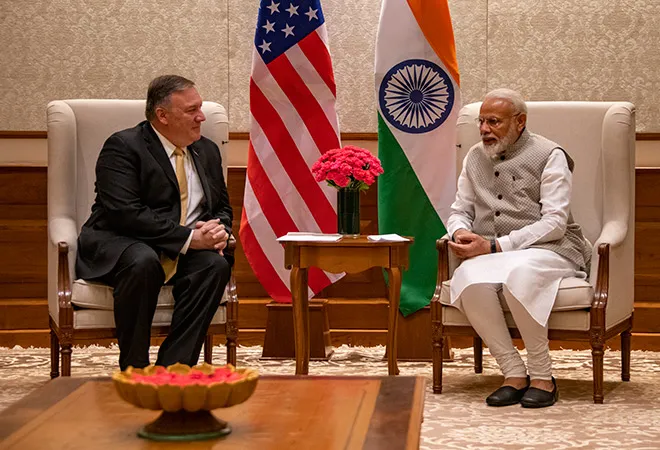
US Secretary of State, Mike Pompeo is currently on a three day (25 to 27 June) visit to India as a part of his week-long tour to the countries of the Indo-Pacific region. His visit to New Delhi is said to be focused on advancing the “incredibly important ties with India” as India is a significant partner in US President Donald Trump’s Indo-Pacific strategy. This visit is significant as this provides an opportunity for the US Secretary of State to promote the US Department of Defence’s recently released (at the Shangri-La Dialogue on 1 June 2019 by the Acting Secretary of Defence, Patrick Shanahan) ‘Indo-Pacific Strategy Report.’ This report outlines the US’ future course of actions and its Indo-Pacific strategy. The report too categorises India as a vital partner of the US in the Indian Ocean region (IOR) and in South Asia given the growing Chinese advances and footprints in the IOR.
Under the Trump administration, noteworthy developments have taken place in the India-US strategic ties like the two countries having kicked off the 2+2 Dialogue, the reinvigoration of the Quadrilateral Dialogue, the operationalisation of the Logistics Exchange Memorandum of Agreement (LEMOA) and the signing of the Communications Compatibility and Security Agreement (COMCASA). This year might see the initiation of the tri-service exercise — the American and the Indian navies undertook a group sail along with the Japanese and the Filipino navies in the South China Sea recently. Defence ties have also improved a great deal with India receiving the Apache and Chinook helicopters and deploying P-8is and C-130s to expand its reach in the Indian Ocean. With US granting India the Strategic Trade Authorization Tier 1 status further exports of advanced technology can happen in the future.
There is a common concern about a rising China which is using its “military modernisation, influence operations, and predatory economics to coerce other nations” and hence impacting the security and stability in the region.
Both the countries regard each other as critical partners in their Indo-Pacific strategies. In principle, the two countries have a similar vision on the principles and values of a Free and Open Indo-Pacific (FOIP). India and the US champion for a FOIP “in which all nations, large and small, are secure in their sovereignty and able to pursue economic growth consistent with accepted international rules, norms, and principles of fair competition; there is peaceful resolution of disputes; adherence to international law including the freedom of navigation and overflight.” There is a common concern about a rising China which is using its “military modernisation, influence operations, and predatory economics to coerce other nations” and hence impacting the security and stability in the region. But, there is a difference in the strategy of the two countries when it comes to dealing with the challenges being faced by the region, especially China. In the US Indo-Pacific Strategy Report, China has been mentioned as a “Revisionist Power.” While the need to engage with China both in defence terms (militarily) and also in economic terms for ensuring positive growth in the Indo-Pacific region has been pointed out, but the stress is put on the fact that “the Indo-Pacific increasingly is confronted with a more confident and assertive China that is willing to accept friction in the pursuit of a more expansive set of political, economic, and security interests.” Though even India sees the Chinese rise as a challenge, but as PM Modi’s 2018 Shangri-La Dialogue keynote speech reflected, India has taken a more subtle attitude towards China and a diplomatic stance in pointing out the “China threat” in global platforms — “India has as many layers as our relations with China. But the two have displayed maturity and wisdom in managing issues and ensuring a peaceful border.” Furthermore for India, the Indo-Pacific encompasses not only the nations that fall within this geographical ambit, but also countries which have a stake in it.
The Indo-Pacific region “is not seen as a strategy or a club of limited members.”
India’s Indo-Pacific vision and policy has been to mainly engage with other players in the diplomatic, economic, connectivity and defence (naval exchanges and exercises, capacity building, maritime domain awareness) realms. The Indo-Pacific region “is not seen as a strategy or a club of limited members.” The US Indo-Pacific strategy too involves diplomatic initiatives, governance capacity building, economic cooperation and commercial advocacy, and military cooperation, but there is a difference in how the US wishes to engage with like-minded countries in these above mentioned aspects. Three methods or means have been proposed in the US Indo-Pacific Strategy Report for engaging its partners in the above mentioned domains — preparedness; partnerships; and the promotion of a networked region. The aspect of ‘promotion of a networked region’ is very much in line with India’s vision whereby the US is also looking to strengthen the alliances and partnerships ‘in a networked security architecture’ to uphold the international rules based order. But the aspect of ‘preparedness’ entail employing deterrence through a Joint Force and the US combat credible forces along with its allies and partners will be forward deployed in the region to “win any conflict from its onset.” By ‘partnerships’ is meant “unique network of allies and partners is a force multiplier to achieve peace, deterrence and interoperable warfighting capability.” For now India’s Indo-Pacific policy has been to boost engagements with like-minded countries of the region on the basis of shared values and interests in the economic, defence and diplomatic sectors. Whether India will delve into such a hardline military cooperation as the US Strategy Report expects from its allies and partners will remain to be seen.
Nonetheless both the countries as mentioned above do agree in principle when it comes to what a ‘Free and Open Indo-Pacific’ should look to achieve. India and the US do also agree that no country alone can ensure the security and stability of the region given the challenges and threats (transnational) it faces, so this leaves enough room for the two to cooperate. Additionally — as has been mentioned by Secretary Pompeo at the India Ideas Summit held on 12 June 2019 that, the US does recognise that India may have a different strategy of dealing with China — “it is different to deal with the likes of China from across the ocean than when it is on your border.”
India and the US agree that no country alone can ensure the security and stability of the region given the challenges and threats (transnational) it faces, so this leaves enough room for the two to cooperate.
The US through its BUILD Act and other economic initiatives like US-ASEAN Smart Cities Partnership, the Indo-Pacific Transparency Initiative is engulfing cooperation with the other countries of the region. Therefore, though the military aspects have been stressed upon in the Strategy report, the need for economic cooperation and upholding economic growth and prosperity of the region have also been highlighted. This does pave the way for India and US to discuss on opportunities for greater economic exchanges and initiatives. Another area which needs to be looked into for strengthening cooperation in the Indo-Pacific is investing for boosting connectivity in the region. There are many ongoing connectivity initiatives in the region like the Masterplan on ASEAN Connectivity 2025 where both the countries can work together considering ASEAN Centrality is supported by both US and India. US can also invest in the India and Japan proposed Asia-Africa Growth Corridor connectivity initiative. There can be talks to look into cooperating in the maritime domain as well — on blue economy, maritime domain awareness (information sharing, surveillance and reconnaissance support, ship rider agreements).
Despite the difference in strategies and visions when it comes to the Indo-Pacific and how the principles of the FOIP needs to be upheld, there are some converging elements as well and the focus should be on those elements during the discussions. Raja Mohan, Director of South Asian Studies at the National University of Singapore, rightly points out that India should continue negotiations with the US and “make progress wherever one can.”
The views expressed above belong to the author(s). ORF research and analyses now available on Telegram! Click here to access our curated content — blogs, longforms and interviews.




 PREV
PREV


